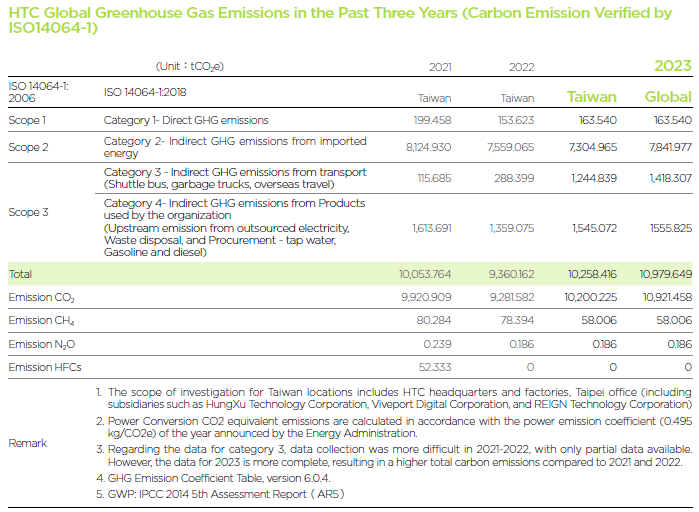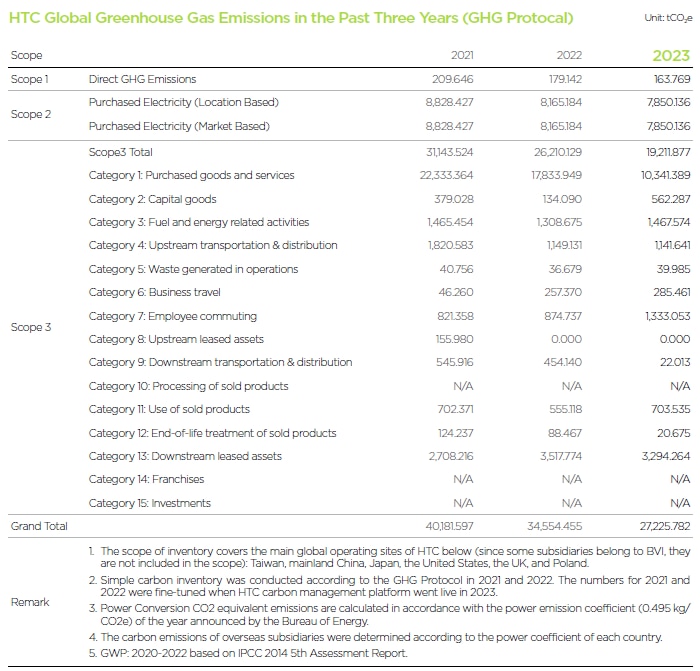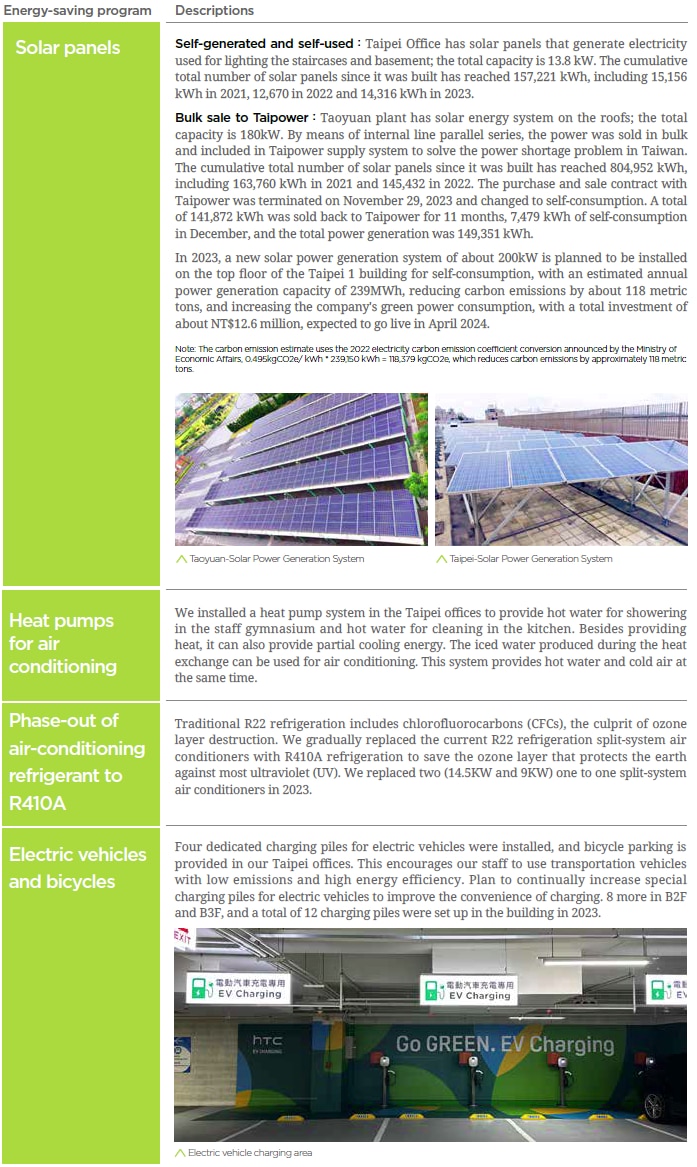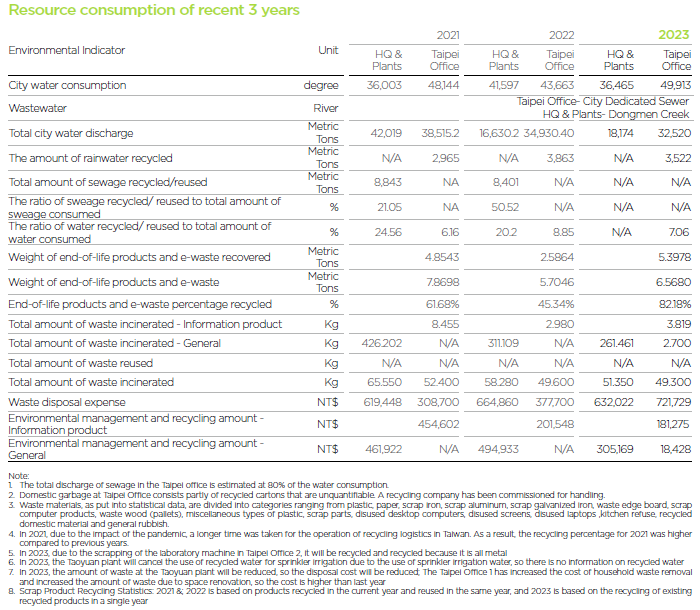Sustainable Environment
HTC is committed to protect environment, integrate the concept into our corporate culture, enhance employees' awareness of environmental protection and caring, improve energy, water and waste management, and reduce the impact to biodiversity. In addition, HTC organizes environmental protection activities for our employees and further improve their environmental awareness. We believe that only through working together can we create more value for the environment and the society. Energy and climate change related action.
Energy and Emission
We have devised a dual-aspect strategy composed of “adopting an energy management system” and “performing energy-saving practice.” On one hand we strive for optimizing our management system to reduce energy consumption, and on the other we use energy-saving technology to improve the energy efficiency of our products.
Electricity Consumption Analysis of HTC Sites in Taiwan

In 2023, the total emissions of greenhouse gases of HTC sites in Taiwan reached 10,258.4157 tCO2e. Compared with the base year of 2021, the variation of greenhouse gases included in the Scope 1 and Scope 2 GHG inventories did not exceed the significance threshold of 3% in 2023. As a whole, CO2 was the major greenhouse gas generated by HTC; CH4 and N2O emissions accounted for a very minimal ratio. PFCs, SF6, NF3, and HFCs emissions were maintained at 0.
HTC expanded the scope of greenhouse emission inventory and external verification to scope 3 in 2014. Relying on the upstream / midstream / downstream greenhouse gas inventory in the complete value chain, HTC accurately identifies the categories and activities with most intensive greenhouse gas emissions to provide suggestions for carbon emission reduction and climate transition strategies. HTC does not emit Sox and other waste gas, nor use substances that may damage the ozone. Environmentally friendly refrigerants extensively applied in the market including R-134a and R-410a are adopted for the refrigerated air conditioning systems in the HTC building. HTC will also continue to plan the replacement of refrigerants of other models with relatively high global warming potential (GWP) value within a certain time limit to lower the sharp warning effect on the earth due to damage to the ozone.
On our path to net-zero, in addition to complying with legal compliance requirements and the expectations of stakeholders, HTC is taking proactive measures to plan ahead:
1. Completed "HTC Carbon Management Platform" construction at the end of 2023 and conducted inventory disclosure and target management of greenhouse gas emissions in full scopes of the company through a real-time, digital, and transparent cloud platform.
2. Used the "HTC Carbon Management Platform" as a tool to complete the inventory and verification of greenhouse gas emissions (2023) in full scopes of the parent company and all subsidiaries by the end of the second quarter of 2024, which is 3 to 4 years ahead of regulatory requirements!

In 2022, HTC promoted the Net-Zero project, and adopted GHG Protocol to implement simple carbon inventory of parent company and subsidiaries of HTC according to SBTi methodology. Also, the company conducted carbon emission analysis, calculation and evaluation in all the scopes, planned a Net-Zero pathway and established relevant short-term, medium-term, and long-term carbon reduction strategies and management indicators with six strategies, i.e., “Carbon Management and Policy, Low-carbon Operation, Low-carbon Products, Low-carbon Transportation, Value Chain Engagement, and Carbon Offset”. In January 2024, HTC signed a commitment with SBTi and generate GHG Protocol inventory reports through HTC's carbon management platform.

We continued to promote multiple energy-saving and carbon-reduction projects, and a total of NT$ 1.63 million was invested in the new replacement of energy-saving improvement equipment in 2023.

Green Building
HTC is committed to reducing its environmental impact. In 2013,
HTC's Taipei Office
obtained the Green Building Label of the Ministry of the Interior and the LEED Gold certification of the US Green Building Council(USGBC). When planning the Taipei Office, we considered sustainability and the use of low energy resources in the design, construction, and operations. From beginning of use of the building to 2023, EUI was 108.26kWh/m2/year.
The Use of Green Energy
To create a low carbon life, we use only green energy, which includes the use of solar panels, eco-cooler air conditioners, and other low carbon emission sources like electric cars.

Water Resource Management
As global warming intensifies and climate change becomes a pressing issue, water resource management has become increasingly important. While our processes require minimal water usage and have low environmental impact on the surrounding areas, we still strive to reduce water consumption and promote water resource management and recycling.
Our water supply comes from Taiwan Water Corporation, and our production processes are dry processes that do not generate wastewater. The wastewater generated is solely from the general office and daily activities of our employees. To ensure that we do not exert any adverse impacts on the water source areas, we refer to the World Resources Institute's "Aqueduct Water Risk Atlas," which indicates that Taiwan as a whole fall into the Low to Medium (1-2) category, posing no immediate threat to water resource. We also conduct wastewater testing to ensure that our discharged wastewater does not pose any negative impact on the water source and the environment.
